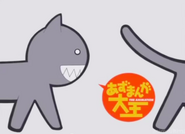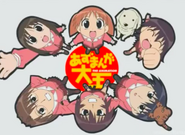
|
This page uses content from Wikipedia. The original article was at Eyecatch. The list of authors can be seen in the page history. As with Azumanga Daioh Wiki, the text of Wikipedia is available under the Creative Commons License. But please try to change as it won't match the page taken from Wikipedia. |
An eyecatch (Japanese: アイキャッチ Aikyatchi) is a transitional feature between a commercial break and a television show that is in most anime. Outside of Japan, it is a commercial and/or bumper. The anime has featured eyecatches from its very beginning.
Unlike in American programs, in which bumps are typically supplied by the network (when they have them at all), eyecatches are almost always produced by the production company and considered a part of the program itself, rather than (or also serving as) a segue into a commercial break. They are typically 2–5 seconds long. Eyecatches for children's programs are often longer and more elaborate, while eyecatches for programming for adults may consist of nothing more than the program's logo against a black background.
Types[]
Most programs use the same eyecatch in each episode, but a few change them every week, or rotate a stable of repeating eyecatches. In tokusatsu productions, such as the Super Sentai series, the eyecatch generally revolves around the character the episode is focused on. If it revolves around two members, one or both characters are shown. Some anime does this as well. The program The Melancholy of Haruhi Suzumiya is a noted exception; there is only one eyecatch in the entire series, which is contained in the first program and is meant to be a riff on anime clichés. Other anime without eyecatches include Elfen Lied, The Big O, and Fullmetal Alchemist.
The anime Air Gear also makes use of humorous eyecatches, such as Agito becoming super deformed.
Often, especially in programs aimed at children, the eyecatch has a secondary purpose: marketing. Pokémon is one of the examples (see below); the purpose of the eyecatch of Pokémon is to help children learn to identify the characters and thus increase brand awareness. Likewise, there is a recent trend among magical girl anime in Japan of using the eyecatches to show the heroine having fun with some gadget or toy, such as those featured in Pretty Cure. The item featured is then made into merchandise and sold. Thus, the eyecatch both creates a product and provides it with free advertising.
There have also been times, at least in anime, where multiple eyecatches are displayed throughout each episode that do not necessarily have to do with commercial breaks. The eyecatches in this case tend to be around five per episode. Examples of this type can be found in such anime as Rec and Tsuyokiss. More over, this is also seen in the anime Pani Poni Dash! where the eyecatches often have scenes pertaining to the episode in question.
Examples[]
Anime[]
- In One Piece, the eyecatches consist of a series of Wanted posters, each depicting one of the show's central characters, who are all pirates and therefore wanted criminals. The character featured is usually central to the episode's plot.
- In D.N.Angel, the eyecatch consists of an animated feather with the show's logo in the corner along with dramatic music. In the fifth episode, as a joke on the phenomenon of the eyecatch itself, this animation is used not only for the commercial break, but during every major scene transition, appearing a half-dozen extra times without explanation. At the end of the episode the eyecatch appears again, causing the characters to yell "KNOCK IT OFF!" at which point the eyecatch music abruptly stops.
- In Pokémon, the eyecatches challenge viewers to identify one of the series' 712 fictional creatures, which is obscured in silhouette. After the commercial break, the answer is revealed. The idea remained in the English version of the television anime as a "Who's that Pokémon?" segment, with the modified background image, until the beginning of the Advanced Generation era (Advanced Challenge in America), when they switched to "Trainer's Choice." "Who's That Pokemon?" returned in the Black and White era.
- Death Note utilizes the eyecatch as a means to educate the viewer about the rules of the Death Note. Each eyecatch reveals a new rule, coinciding with the motives of the main character, and does not interrupt the plot itself.
- In Yu-Gi-Oh GX, eyecatches are used with one or two characters which are currently dueling against each other or has the episode centered mainly on them.
- In the second season of Kaleido Star, an eyecatch is used before and after a commercial break that shows a super deformed Sora Naegino possibly practicing moves on the trapeze and tightrope.
- In Yu Yu Hakusho, the eyecatch is super deformed-forms of the main characters attacking eyeball monsters that turn into the kanji of the title of the show. Yusuke also shoots the kanji with his Spirit Gun a few extra times to line them up. Finally, Koenma falls on top of Kuwabara's head.
- Some series has in each episode a different eyecatch with an exclusive artwork related to it, like in Dragonball GT, where every week a group of the show's characters are stuffed in a car driving somewhere. Some come to the extent of putting two new ones (at the start and end of the break respectively) every week. One example is Tengen Toppa Gurren Lagann.
- In Shuffle!, two sets of eyecatches are used – one for generally comedic episodes, another for the dramatic episodes. The comedic eyecatches shows Primula's stuffed toy doing moves a la Street Fighter and sharing a squid with another cat; the dramatic eyecatch shows the major female characters in the nude with the censored bits cleverly hidden.
- In Bokusatsu Tenshi Dokuro-Chan, the eyecatch is (with one exception) Dokuro accidentally killing herself in one of several ways.
- In GaoGaiGar, the eyecatch includes technical descriptions of GGG mechs, equipment, Gao Machines and so on with small but readable English text describing in more detail, this trend is continued in OVA sequel GaoGaiGar Final.
- In Mermaid Melody Pichi Pichi Pitch, Lucia flips a card and show the expression of the heroines, which character they drew. When the commercial is over in the second half of the eyecatch, they will show which character they have flipped.
- In the first season of Keroro Gunsou in which Sgt. Keroro emerges from the water with a sign bearing the title of the series, the word "EYECATCH" in English can be seen printed in the background.












